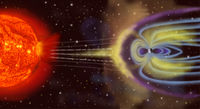
Photo from wikipedia
Storm events can drive highly variable behaviour in catchment nutrient and water fluxes, yet short-term event dynamics are frequently missed by low resolution sampling regimes. In addition, nutrient source zone… Click to show full abstract
Storm events can drive highly variable behaviour in catchment nutrient and water fluxes, yet short-term event dynamics are frequently missed by low resolution sampling regimes. In addition, nutrient source zone contributions can vary significantly within and between storm events. Our inability to identify and characterise time-dynamic source zone contributions severely hampers the adequate design of land-use management practices in order to control nutrient exports from agricultural landscapes. Here, we utilise an 8-month high-frequency (hourly) time series of streamflow, nitrate (NO3-N), dissolved organic carbon (DOC), and hydroclimatic variables for a headwater agricultural catchment. We identified 29 distinct storm events across the monitoring period. These events represented 31% of the time series and contributed disproportionately to nutrient loads (42% of NO3-N and 43% of DOC) relative to their duration. Regression analysis identified a small subset of hydroclimatological variables (notably precipitation intensity and antecedent conditions) as key drivers of nutrient dynamics during storm events. Hysteresis analysis of nutrient concentration-discharge relationships highlighted the dynamic activation of discrete NO3-N and DOC source zones, which varied on an event-specific basis. Our results highlight the benefits of high-frequency in situ monitoring for characterising short-term nutrient fluxes and unravelling connections between hydroclimatological variability and river nutrient export and source zone activation under extreme flow conditions. These new process-based insights, which we summarise in a conceptual model, are fundamental to underpinning targeted management measures to reduce nutrient loading of surface waters.
Journal Title: Journal of Geophysical Research
Year Published: 2017
Link to full text (if available)
Share on Social Media: Sign Up to like & get
recommendations!